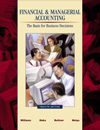Chapter 4 - Summary LO 1 Explain the purpose of adjusting entries. The purpose of adjusting entries is to allocate revenue and expenses among
accounting periods in accordance with the realization and matching principles.
These end-of-period entries are necessary because revenue may be earned and
expenses incurred in periods other than the one in which the related transactions
are recorded. LO 2 Describe the four basic types of adjusting entries. The four basic types of adjusting entries are made to (1) convert assets to
expenses, (2) convert liabilities to revenue, (3) accrue unpaid expenses, and
(4) accrue unrecorded revenue. Often a transaction affects the revenue or expenses
of two or more accounting periods. The related cash inflow or outflow
does not always coincide with the period in which these revenue or expense items
are recorded. Thus, the need for adjusting entries results from timing differences
between the receipt or disbursement of cash and the recording of revenue or
expenses. LO 3 Prepare adjusting entries to convert assets to expenses. When an expenditure is made that will benefit more than one accounting period,
an asset account is debited and cash is credited. The asset account is used
to defer (or postpone) expense recognition until a later date. At the
end of each period benefiting from this expenditure, an adjusting entry is made
to transfer an appropriate amount from the asset account to an expense
account. This adjustment reflects the fact that part of the asset's cost has
been matched against revenue in the measurement of income for the current
period. LO 4 Prepare adjusting entries to convert liabilities to revenue. Customers sometimes pay in advance for services to be rendered in later accounting
periods. For accounting purposes, the cash received does not represent
revenue until it has been earned. Thus, the recognition of revenue must
be deferred until it is earned. Advance collections from customers are
recorded by debiting Cash and by crediting a liability account for unearned
revenue. This liability is sometimes called Customer Deposits, Advance Sales,
or Deferred Revenue. As unearned revenue becomes earned, an adjusting entry
is made at the end of each period to transfer an appropriate amount from the
liability account to a revenue account. This adjustment reflects the
fact that all or part of the company's obligation to its customers has been
fulfilled and that revenue has been realized. LO 5 Prepare adjusting entries to accrue unpaid expenses. Some expenses accumulate (or accrue) in the current period but are not
paid until a future period. These accrued expenses are recorded as part
of the adjusting process at the end of each period by debiting the appropriate
expense (e.g., Salary Expense, Interest Expense, and Income Taxes Expense),
and by crediting a liability account (e.g., Salaries Payable, Interest Payable,
and Income Taxes Payable). In future periods, as cash is disbursed in settlement
of these liabilities, the appropriate liability account is debited and Cash
is credited. Note: Recording the accrued expense in the current period
is the adjusting entry. Recording the disbursement of cash in a future period
is not considered an adjusting entry. LO 6 Prepare adjusting entries to accrue uncollected revenue. Some revenues are earned (or accrued) in the current period but are
not collected until a future period. These revenues are normally recorded
as part of the adjusting process at the end of each period by debiting an asset
account called Accounts Receivable, and by crediting the appropriate revenue
account. In future periods, as cash is collected in settlement of outstanding
receivables, Cash is debited and Accounts Receivable is credited. Note:
Recording the accrued revenue in the current period is the adjusting entry.
Recording the receipt of cash in a future period is not considered an
adjusting entry. LO 7 Explain how the principles of realization and matching relate
to adjusting entries. Adjusting entries are the tools by which accountants apply the realization
and matching principles. Through these entries, revenues are recognized as they
are earned, and expenses are recognized as resources are used
or consumed in producing the related revenue. LO 8 Explain the concept of materiality. The concept of materiality allows accountants to use estimated amounts and
even to ignore other accounting principles if these actions will not have a
material effect on financial statements. A material effect is one that might
reasonably be expected to influence the decisions made by users of financial
statements. Thus accountants may count for immaterial items and events in the
easiest and most convenient manner. LO 9 Prepare an adjusted trial balance and describe its purpose. The adjusted trial balance reports all of the balances in the general ledger
after the end-of-period adjusting entries have been made and posted.
Generally, all of a company's balance sheet accounts are listed, followed by
the statement of retained earnings accounts, and finally, the income statement
accounts. The amounts shown in the adjusted trial balance are carried forward
directly to the financial statements. The adjusted trial balance is not
considered one of the four general purposes financial statements introduced
in Chapter 2. Rather, it is simply a schedule (or tool) used in preparing
the financial statements. In this chapter we have examined adjusting entries made for the accrual and
deferral of expenses and revenue. In Chapter 5, we complete the remaining steps
of the accounting cycle by illustrating the preparation of financial statements,
the end-of-period closing process, and the after-closing trial balance. | 


 2002 McGraw-Hill Higher Education
2002 McGraw-Hill Higher Education